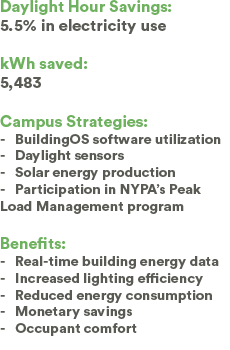Process
Encouraged by the University Director of Sustainability at CUNY, Queens College, along with 5 other CUNY institutions, participated in Daylight Hour. The sustainability council of each college coordinated its participation. Queen College’s participation in Daylight Hour was similar to their involvement in NYPA’s Plug Load Management (PLM) program. They drastically reduced energy use within a specific time frame while educating students and faculty about the motive. As a participant of PLM, the campus already monitors real-time energy data and has a procedure to educate its community.The sustainability council placed posters by elevators and doors to increase awareness about the campaign. In addition, the Vice President of Finance & Administration notified all faculty and staff about Daylight Hour three times: a week prior, a day prior, and the day of. These notifications emphasized safety and requested that occupants only turn off the lights where sufficient daylight is available. During Daylight Hour, Queen College’s entire custodial team of 75 turned off any unnecessary lighting across all 43 buildings. Because Queens College joined the initiative only a few weeks prior to the event, the sustainability council had limited time to prepare a targeted education and outreach plan with the communications department. In addition, there are no classes on Fridays during the summer (when Daylight Hour occurs), which prevented the sustainability council to involve students in the campaign.

Project Team
CUNY Queens College
Project Owner
Performance
During Daylight Hour, Queens College campus saved an impressive 5,483 kWh, 5.5% of their typical daily total electrical consumption. The Campus Facilities team used Lucid Engineering’s BuildingOS software to visualize the savings and quantify Daylight Hour’s impact. This software collects real-time data of each building’s energy use. Using the software’s customized comparison tool, the team was able to compare multiple time frames. They compared the energy use from one-year prior (June 20, 2014) and one-week prior (June 12, 2015) to Daylight Hour (June 19, 2015). The BuildingOS software also indicated which buildings saved the most energy. Due to significant savings from Daylight Hour, the sustainability council garnered support to observe the initiative every other Thursday for the remaining of the summer. This created an average 2-3% electrical savings per day. For Daylight Hour 2016, Queens College intends to involve students who will coordinate the campaign’s educational and social media outreach and observe Daylight Hour once a month.
Benefits
• Real-time building energy data
• Increased lighting efficieny
• Reduced energy consumption
• Monetary savings
• Occupant confort
Conclusion
Queens College launched a successful Daylight Hour campaign by leveraging their experience with NYPA’s Peak Load Management program and dedicating staff to turn off the lights in day-lit spaces. Their primary challenge was not having sufficient time to coordinate the campus-wide education and outreach plan they envisioned. In 2016, the sustainability council will involve students to help produce educational posters and materials, as well as to coordinate a social media strategy to showcase Queens College’s participation. Queens College is a strong example of the over 300 participating organizations and companies that BEEx engaged for Daylight Hour. It is this enthusiasm that Daylight Hour’s impact spanned 58 million square feet of office space, reaching over 1 million people on social media, and most importantly, saving enough energy in just one hour to power 15 New York households for an entire year.
“Queens College’s participation in Daylight Hour is a win-win for all involved. It was an interactive event that engaged students, faculty and staff, saved electrical costs, and promoted the well-being of buildings’ occupants through natural light.